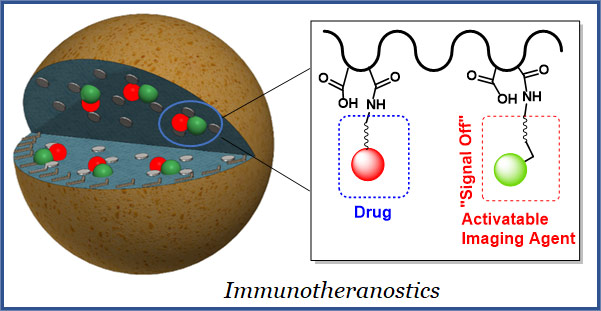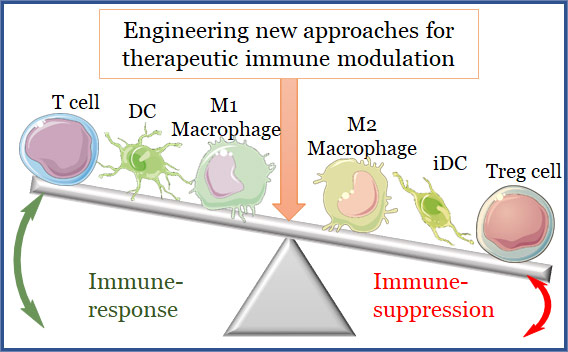
Overall Research Theme:
Dysregulated immune system activation is at the root of several diseases: overactivation can lead to autoimmunity and underactivation can lead to immunodeficiency, compromise resistance to infections and allow for the development of malignancy. Our group works at the interface of engineering and immunobiology to develop innovative technologies for achieving the precise level of immune activation to treat diseases and improve human health. We innovate tools and platform technologies by utilizing the individual strengths of diverse areas including nanotechnology, supramolecular chemistry, glycan engineering, computational chemistry, molecular imaging, mathematical modeling, genome engineering and immunology. Specific research areas are described below.
Immunoengineering Platforms:
Most of our understanding of immune system interactions in diseases is still limited by the lack of proper tools and techniques. We develop ‘Immunoengineering’ platforms to understand and quantitatively study the interactions between different components of the immune system in health and disease. We engineer novel disease-on-a-chip platforms for understanding the immune cells interactions while also maintaining the cellular microenvironment at physiologically relevant length and time scale that is crucial to identify novel targets and design therapies for different diseases including cancer, diabetes, autoimmune diseases etc.
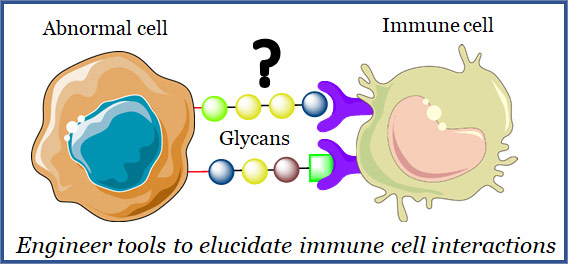
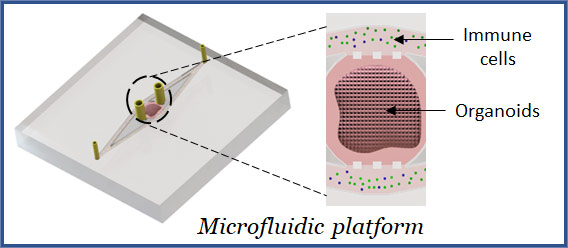
Microfluidics:
We are engineering microfluidic-based platforms that can mimic in vivo disease microenvironment to study the interactions between different immune cells such as innate and adaptive immune cells and, between also abnormal cells (e.g. cancer cells) and immune cells. We systematically study the impact of different physiologically relevant parameters such as flow, shear stress, interactions time on the cell- cell interactions. We are also developing imaging tools that can be adapted to microfluidic platforms for real-time imaging of the interactions. These platforms can be adapted to study different cell interactions as well as screen small molecules, antibodies, peptides or nanoparticle systems that can perturb these interactions.
Glycan Engineering:
Cell surface glycan structures correlate with disease progression as well as play a critical role in cell-cell communications and immune functions. However, limited studies have been performed to harness these glycans to understand the fundamental cellular processes and to modulate the immune cell interactions in different diseases. We design new approaches for the synthesis of biologically-inspired and chemical-defined glycans of different structures and architecture to study structure-function relationships in glycan-mediated processes. We use these glycan engineering platforms to study the factors that govern protein-glycan interactions in the context of immune cell communications in diseases. Additionally, we are developing novel techniques to adapt these glycans to different platforms including microfluidics which can allow us to dissect the interactions between abnormal cell-immune cell or different immune cells in a physiologically relevant environment.
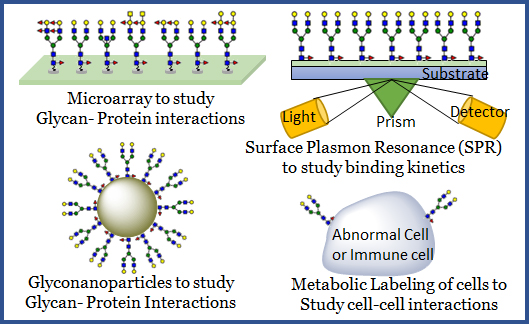
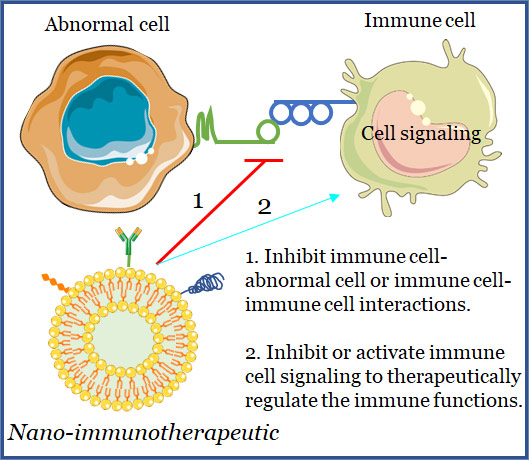
Immunotherapeutics:
A major thrust of our lab is to engineer novel nanomaterials that can perturb the immune cell interactions in a spatial and temporal manner, and therapeutically modulate the immune cell functions. While, the design of the nanomaterials is driven by basic immunological understanding of the disease, we exploit cutting edge approaches in the synthesis of these materials. For examples, we have developed a completely new platform technology, called supramolecular nanotherapeutics for tissue-specific delivery of immunomodulatory agents. We have designed the first-of-its-kind computational algorithm for high throughput synthesis of supramolecular nanotherapeutics. We are also developing self-assembling polymeric nanomaterials by rational re-engineering of the drug or polymeric backbone. With these platform technologies, we are uniquely poised to deliver a variety of agents to specific targets that can inhibit immune cell – abnormal cell or immune cell- immune cell interactions, and therapeutically regulate the immune functions by either inhibiting or activating immune cell signaling in a sustained manner. We are also developing genome engineering platforms for cell based therapies that can be used in combination with immunotherapeutics.
Supramolecular nanotherapeutics:
The stability of nanoparticles at drug concentrations required for clinical efficacy has been a major challenge in the clinical translation of nanomedicines. To address this, we have developed a novel platform technology, called supramolecular therapeutics, where we design small molecular subunits that act as active drugs but like LEGO blocks can self-assemble with each other and with additional inactive excipients through weak, non-covalent interactions to form nanoscale structures. We have shown that the supramolecular nanotherapeutics exhibit unique ability to home into tissue of interest (e.g. tumor) and result in a sustained inhibition of the target and the downstream signals, thus offering a spatial and temporal control over signal transduction pathways either in abnormal cell or immune cells. We are working on using this platform to deliver immunomodulatory agents to focally modulate immune contexture to treat different diseases.
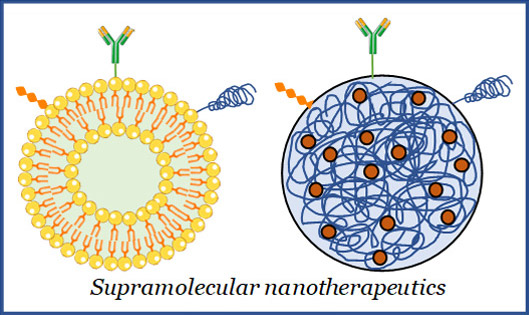

Computational algorithm:
To enable high throughput synthesis of nanomaterials, we are developing first-of-its-kind in silico platform technology, which allows us to design the building blocks that can undergo stable supramolecular nanostructures. We are working on adapting this high throughput platform for delivery of different immunomodulatory agents including small molecule inhibitors, antigens and adjuvants, immune checkpoint antibodies, proteins as well as for optimizing combination therapies.
Immunotheranostics:
The holy grail in successful immunotherapy is to visualize the efficacy response early on. Current visualization techniques lack the sensitivity and specificity to monitor the response effectively. To address this problem, We are developing ‘Immunotheranostic’ (therapeutic + diagnostic) platform technology that can enable spatiotemporal delivery of an immunotherapy drug and drug function-activatable imaging agent. This technology can not only allow direct and real-time visualization of immunotherapy effect thereby studying heterogeneity in immunotherapy response but can also be utilized to probe interesting biological questions by real-time monitoring of cellular level immune responses.
